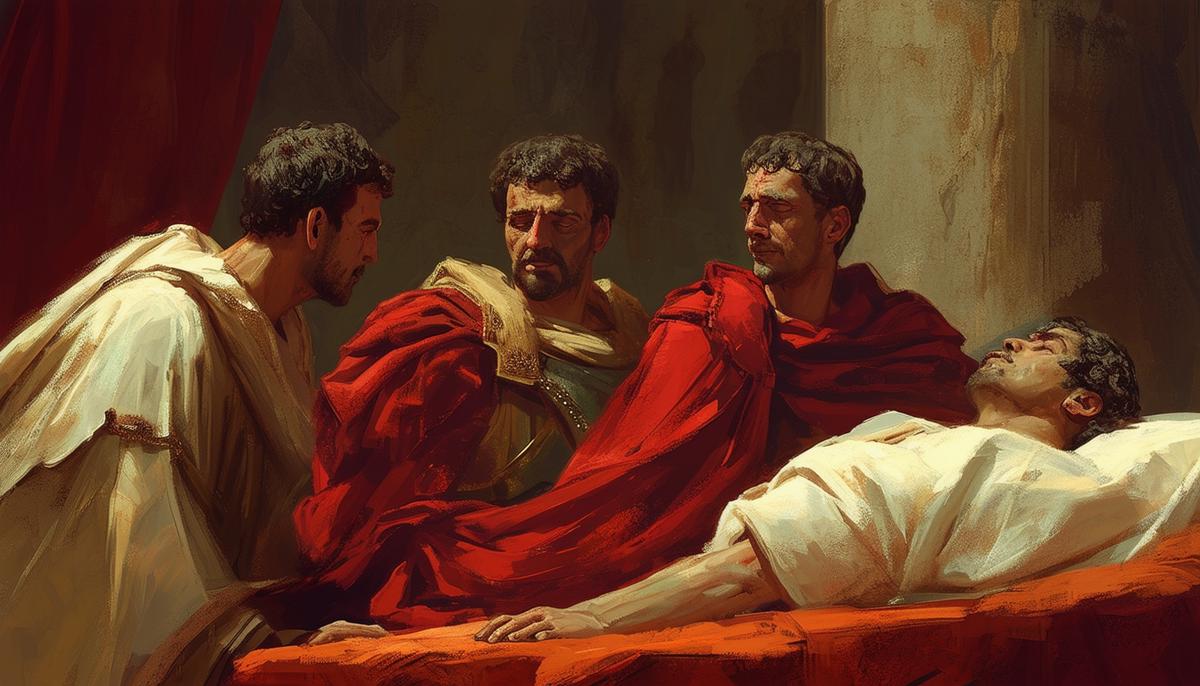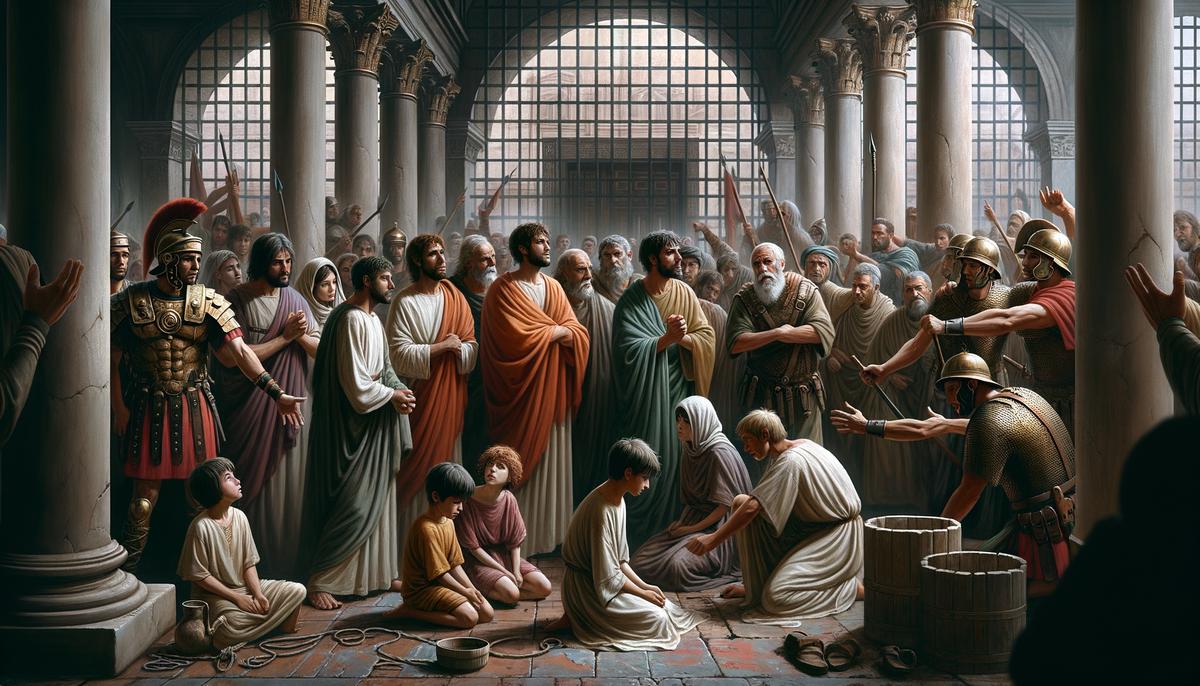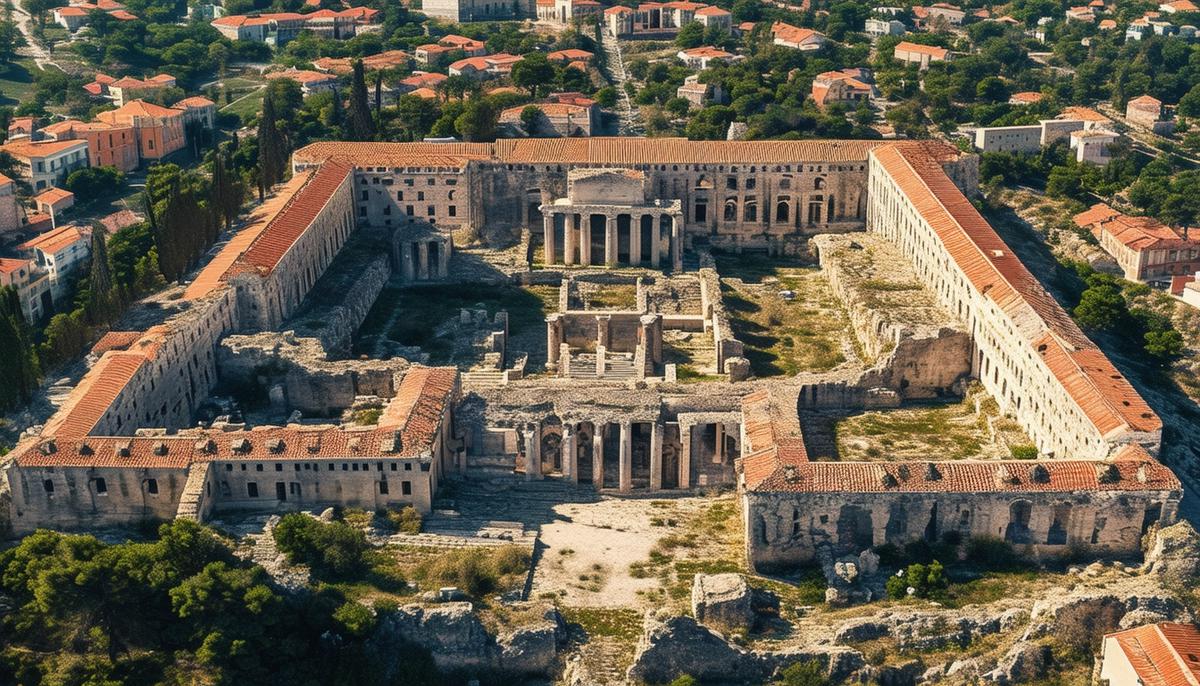Rise to Power
Diocletian, born around 245 CE in the Roman province of Dalmatia, ascended from humble beginnings. His rise through the military ranks was both sharp and shrewd; by adulthood, he had secured his position as commander of the emperor's cavalry under Carus. This move strategically positioned Diocletian at the center of imperial power.
Upon the death of Emperor Carus in 283 CE and subsequently his son Numerian in 284 CE, a whirlwind of intrigue and power struggles enveloped the corridors of power. Numerian's mysterious demise during a military campaign in Persia presented a pivotal moment. Initially reported dead from illness inside his litter, whispers of foul play circulated, directed toward his father-in-law Aper, who was the praetorian prefect. Amid this maelstrom, Diocletian's fortunes would sharply turn.
In a dramatic sequence of events, Diocletian was hailed emperor by his soldiers in 284 CE. He used this acclaim to his advantage in a demonstration of power and authority. During an assembly of the army, Diocletian accused Aper of the murder of Numerian, and without a trial, slayed him with his own hands. This act asserted his innocence and conveyed a clear message to any detractors of his approach.
However, securing his position as uncontested leader was no simple task. Carinus, Numerian's brother and co-emperor, already held sway over the Western provinces. The ultimate confrontation unfolded in 285 CE at the Battle of the Margus River. Though historical accounts vary, with indications that Carinus initially gained the upper hand, his unforeseen assassination by his own troops switched the balance—providing Diocletian uncontested control over the vast Roman Empire. Diocletian's strategy extended beyond sheer force; he was astutely aware of the importance of perception and legitimacy. By portraying himself as the avenger of Numerian and positioning himself as a stabilizer capable of rectifying the disorder that plagued Rome's corridors of power, he turned tumultuous times into a ladder to climb to power.
This initial consolidation marked just the beginning, as Diocletian proved equally adept at handling the intricacies of administrating an extensive empire. Not content with traditional methodologies, Diocletian embarked on audacious reforms that fundamentally altered the Roman imperial framework—most notably through the institution of the Tetrarchy, sowing seeds for a substantial transformation of the Roman political landscape.

Implementation of the Tetrarchy
The need for a dramatic alteration in the administrative makeup of the empire was apparent to Diocletian. His strategic approach veered towards an ingenious solution—to divide power in a way that addressed the territorial vastness and political intricacies of Rome. Thus, the concept of the Tetrarchy emerged as a necessary evolution in the empire's governance, addressing issues of succession, regional autonomy, administrative efficacy, and military responsiveness.
In 293 CE, Diocletian formalized the Tetrarchy by appointing two junior co-emperors, or Caesars—Galerius and Constantius Chlorus—each responsible to one of the senior emperors, or Augusti. Diocletian retained oversight of the Eastern provinces, appointing Galerius as his Caesar, while Maximian controlled the Western regions, with Constantius as his deputy. This arrangement was carefully calculated; each ruler was stationed at strategic points within the empire, improving crisis response times and enabling more effective governance of distant provinces.
The brilliance of this system lay in its attempt at establishing a clear succession plan. Under this framework, the Caesars were groomed to ascend as Augusti upon the abdication or death of their predecessors. This theoretically ensured a smooth transition of power, a remedy to the violent succession conflicts that had beleaguered the empire previously.
Reflecting on the supreme office, Diocletian imbued the role of Augustus with authority, entwined with divine right. This elevation sought to reinstall a sense of reverence towards the emperor, a mantle that had eroded during the incessant turmoil of prior decades. Each member of the Tetrarchy assumed roles that were interlocked in mutual supervision as well as competition, a check against the absolute consolidation of power.
Impact on governance was profound. Administering an empire through four rulers allowed for more localized and swifter decision-making processes. Infrastructure improvements and defensive measures could be implemented more directly, adapted to regional needs without the convolution of distant bureaucratic delays. Economically, this model aimed to stabilize the vastly distributed territories by optimizing resource management and addressing local socio-economic conditions more effectively.
However, Diocletian's carefully crafted system, though revolutionary, was not without its challenges. The practical application of such a governance model needed stringent coherence to its conceptual blueprint, a fidelity less certain under the complex interplay of individual ambitions and external pressures.
The Tetrarchy, therefore, stands as a fascinating historical attempt to mold imperial governance into a more pragmatic and enduring structure. Although not eternal in its original form, Diocletian's imprints on political theory and administrative practice cast long shadows on the corridors of power that followed, feeding into future governmental evolutions within the vestiges of the Empire. The groundwork laid by this reformatory leap would echo through the intricate political networks of medieval Europe, remembered as an attempt to stabilize and perpetuate Roman dominion across its sprawling territories.

Economic and Administrative Reforms
Having mastered the art of political maneuver through the implementation of the Tetrarchy, Diocletian demonstrated equal acumen in confronting the economic decay corroding the empire's vitals. With inflation rampant and the state's treasury nearing insolvency, his economic and administrative reforms targeted reconstruction on a massive scale.
Diocletian's reinvention of the taxation system began a period of governmental overhaul. Recognizing the inefficiencies and inequities of the prior tax regime, Diocletian initiated a census to reassess property values accurately and equitably across the empire. This reform aimed at streamlining revenues while ensuring fairer allocation of tax burdens, dismantling older systems that would frequently allow wealthier provinces and individuals to exploit loopholes. These measures were pivotal in stabilizing government finances, and Diocletian's fiscal strategies restored confidence in Rome's economic stability among its populace.
Equally influential were Diocletian's price controls, encapsulated in his Edict on Maximum Prices. In 301 CE, facing escalating prices due to severe currency devaluation, Diocletian attempted to impose a ceiling on the price of over a thousand goods and services, ranging from food items and raw materials to wages. This was a direct approach intended to curb inflation and protect the socio-economic framework during a period filled with uncertainties. While this edict was theoretically sound, its practical impacts were mixed; the prices set were often ignored on the black market or in rural areas where enforcement waned. As a result, though this attempt at price control displayed imperial concern for economic disruption, it highlighted the limitations of autocratic decree over economic behaviors.
Furthermore, Diocletian's separation of civil and military offices marked a significant stride toward specialized governmental roles within the empire. Prior rulers had seen these roles combined, which permitted military governors undue influence and precipitated power struggles. By splitting these roles, Diocletian aimed to refine administrative efficiency and curtail the military's direct involvement in governance, intending to deter the rise of potential usurpers from within the military establishment. Governors could now focus solely on civil administration, while military commanders concentrated on defense and order. Both branches operated under increased scrutiny from centralized imperial oversight, reducing their scope for autonomous power accumulation.
These reforms crafted under Diocletian's rule indeed etched deep imprints on Rome. Economically, by consolidating imperial revenue systems and standardizing tax laws, he restored a semblance of fiscal order necessary for sustaining long-term governance. Administratively, by defining clearer separations between military and civil responsibilities, he enhanced organizational clarity and governance quality. However, the longevity of these reforms' effectiveness varied, influenced heavily by successive leaders' investments in these systemic changes.
Diocletian's legacy speaks to the arduous endeavor of governing an empire—not only in surviving crises but possibly emerging even mightier in their wake.

Religious Policies and Persecution of Christians
With religious fervor almost as complex as the socio-political machinations of his time, Diocletian's reign significantly intertwined with the broad spectrum of religious life within the Roman Empire. As the empire was predominantly pagan in orientation, Emperor Diocletian sought both to align himself with traditional Roman deities and to utilize religion as a unifying sociopolitical force, reinforcing his authority and the stability of his reign through fostering common religious identities.
Despite these efforts at reinforcing traditional religious practices, Christianity posed a unique challenge. Christians, though still a minority, had permeated various strata of society, even finding footholds within high governmental positions. Their distinct departure from Roman religious and social norms—they declined to worship the emperor as a deity or partake in state festivals—placed them at odds with fundamental aspects of Roman state ideology that preached unity through shared worship of state-approved deities and participation in public rituals.
The motivations behind Diocletian's hardening stance against Christians are both intricate and speculative, intertwined with political, social, and religious threads. On one hand, Diocletian may have been predisposed to view Christianity's monotheistic foundations as inherently subversive to the polytheistic, emperor-centric state religion which buttressed his own divine portrayal. Yet, unlike his predecessors, Diocletian initially adopted a policy of relative tolerance towards Christians in the early part of his reign. It was only later, influenced by co-emperor Galerius, that Diocletian commenced a more stringent approach toward Christianity.
This transformation culminated in the year 303 CE, marked by the promulgation of the first Edict against the Christians. A cascade of legal decrees ensued thereafter, collectively known as the Great Persecution. These edicts enjoined the destruction of churches and scriptures, prohibited Christian gatherings, and demanded that Christians conform to traditional Roman religious practices under threat of imprisonment or execution. Notably, while coercive and destructive, the implementation and bearing of these edicts varied greatly across the empire, influenced heavily by provincial governors' zeal or lack thereof and regional sentiments towards Christians.
The immediate consequences of this wave of persecution were multifaceted. Fractures formed within Christian communities between those who complied with imperial decrees and those who defied them; many leaders and laypersons were martyred or apostatized under duress. Though intended to reconsolidate Roman religious culture and galvanize homogeneity throughout the empire, Diocletian's religious campaigns inevitably sowed further discord.
As the political dynamics simmered with the notions of orderly succession post-Diocletian and with the eventual rise of Constantine, a reevaluation of Rome's relationship with Christianity was unavoidable. Contrary to Diocletian's intentions, rather than extinguishing the Christian movement, the persecutions imparted a resilient solidarity among surviving adherents. Far from eradicating the growing Christian faith, Diocletian's harsh policies set the stage for its social entrenchment and eventual imperial endorsement by his successors.
In reflecting on Diocletian's interventions in the religious canvas of the empire, questions linger about the efficacy and consequences of imperial interference in spiritual matters. Was Diocletian's intent on precipitating theological unity meant to fortify societal integration, or was this venture an imperial overreach delving deeply into individual piety? Such a retrospective inquiry paints a picture of an era where the sword and the spirit were contentious companions, and authoritative decrees could scarcely curb the private convictions of an empire's citizenry. Thus, Diocletian's religious policies are emblematic of a broader struggle—a contested terrain where the domains of divine grace and civic governance met with both collision and coalescence—each vying for primacy within the halls of Roman grandeur.

Abdication and Legacy
In an unprecedented turn of events, Diocletian chose to divest himself of the imperial mantle in 305 CE, setting a precedent that fundamentally altered perceptions of the imperial tenure. The critical historical 'May 1' found both Diocletian and his co-emperor Maximian resigning, marking an about-face from the ritually ordained perpetuity expected of a Roman emperor. Yet, Diocletian's exit was not merely an act of retirement but also a tactically astute move ensuring the first test of his Tetrarchic system's viability, wherein transfer of power happened in a controlled and pre-planned manner.
Diocletian retired to his grandly structured palace in Split, modern-day Croatia, reflecting his desire to return to his roots near the Adriatic, the backdrop of his obscure and modest beginnings. Here, between the looming walls that combined the luxurious with the defensive, Diocletian led a conspicuously private post-reign life. Unlike many of his predecessors whose lives ended in violent strife or were marred by attempts to reclaim power, Diocletian's seclusion reflects an adherence to his own system, refraining from undermining the succession framework he had established.
Analyzing Diocletian's vivid imprint on history, his establishment of the Tetrarchy reveals a deep strategic intent aimed at addressing key vulnerabilities of Roman imperial governance: contention over succession and an over-extended bureaucratic administration. Though succeeding temporarily in curbing civil strife born from dynastic ambitions, the quadruplicity of rulers within the Tetrarchy inadvertently laid groundwork for new factions and rivalries, highlighted vividly after Diocletian's abdication. The face-off between Diocletian's successors signified the looming intricacies and deficiencies within the system, leading to Constantine's eventual reconsolidation of power into a sole emperorship.
Diocletian's reign is a crucial inflection point fueling transition from the Principate (characterized by an ostensibly restored republic) to the Dominate, which saw open absolutism embodied in the divine station of the emperor—a solidification and visibility of imperial authority reflected across the sprawling areas of administration and cultural facets including law, the military and religious conduct. Despite its inherent focus on robust administration, Diocletian's intent molded much about the Byzantine governance structure, notably so in continuing the themes of centralized authority and sophisticated bureaucracy. From intricate tax reforms to jurisdictional adjustments and provincial reshaping—many effects rippled well into the Byzantine period, setting scaffolds for how empire-wide governance could be rationalized under singular autocracy interwoven with systematic regional oversight.
Fractures aside, Diocletian's policies and especially his abdication laid bare the existential conundrum of absolute power—its burning intensity cannot forge permanence in profoundly isolated spheres. Governance systems engender continuity not merely by structures but by institutional adaptability unencumbered by the unyielding truths of human ambition and socio-political evolution. His legacy furnishes a telling composite that balances between instrumental reformations and their latent limitations when sailing through tumultuous corridors of power extensive enough to shape the cathedral of history called Rome.

Let Writio, the ultimate AI writer, craft compelling content for your website. This page was expertly written by Writio.
Leave a Reply